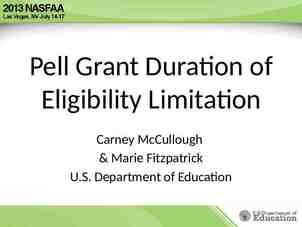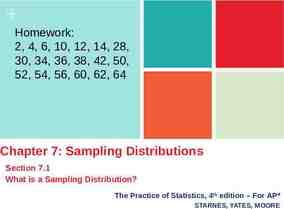Failure Mode Effects Analysis (FMEA) PRESENTED BY THE UNIVERSITY OF
25 Slides389.59 KB
Failure Mode Effects Analysis (FMEA) PRESENTED BY THE UNIVERSITY OF TEXAS-SCHOOL OF PUBLIC HEALTH This material was produced under grant number SH-22316-SH-1 from the Occupational Safety and Health Administration, U.S. Department of Labor. It does not necessarily reflect the views or policies of the U.S. Department of Labor, nor does mention of trade names, commercial products, or organizations imply endorsement by the U.S. Government.
Learning Objectives By the end of this module participants should be able to: Identify the definition of Failure Mode And Effects Analysis (FMEA) Describe how to apply FMEA in the procedure of design, process, and project. Identify the terminology of failure mode, effect and cause, severity, occurrence, detection, and current controls. Select the appropriate methods and strategies to apply Failure Mode And Effects Analysis (FMEA) in the hospital nurse unit. Develop a completed FMEA using Risk Priority Numbers (RPNs) in the hospital nurse unit.
The DMAIC Process with Tools DAY 2 Define Measure Analyze Improve Control PHASE Tools: FMEA Quick Wins 5S The 8 Wastes 3&4
What Is an FMEA? A structured approach to: –Identify the ways in which a product or process can fail –Estimate the risk associated with specific causes –Prioritize the actions that should be taken to reduce the risk A Process FMEA will: –Capture the entire process and the key inputs (Xs) –Identify ways the product or process can fail because of these Xs –Facilitate the documentation of a plan to prevent those failures
Applications For FMEA Design: Used to analyze product designs before they are released to production. A DFMEA should always be completed well in advance of a prototype build. Focuses on product function. Process: Used to analyze manufacturing, assembly, or any other processes. Focuses on process inputs. This is the topic for this module. Project: Documents and addresses failures that could happen during a major program
KEY SOURCE MATERIAL FOR AN FMEA PAPERWORK TURN STEAM ON TO DICY TANK BILL OF MATERIALS SCALE ACCURACY ISO PROCEDURES PREHEATING REWORK LOAD DMF LOAD DICY LOAD ACCURACY LOAD ACCURACY CLEANLINESS ENVIRONMENT (HUMIDITY) RAW MATERIAL RAW MATERIAL MIXER SPEED LOAD 2MI LOAD ACCURACY ENVIRONMENT (HUMIDITY) RAW MATERIAL 1 Process Map Process Map MIXER SPEED FMEA FMEA
The FMEA Form - The Analysis Section Process Step/ Input Potential Failure Mode Potential Failure Effects S E V The FMEA Form What is the The Analysis Section Effect on the What can go wrong with the Process Step? What is the Process Step Outputs? Potential Causes O C C 0 0 0 0 0 0 0 How serious is such an Effect? What are the Potential Causes? Current Controls D R E P T N 0 0 0 0 0 0 0 0 0 0 0 0 0 How often is the cause likely to occur and result in a Failure Mode? How can this be found? How well can we detect a cause before it creates a Failure Mode and Effect? Action Section If risk is too high, what can be done? Estimated risk is “Sev” x “Occ” x “Det”
Definition Of Terms – Failure Mode Failure Mode: The way in which a specific process input fails If it is not detected and either corrected or removed, it may cause a negative “Effect” to occur Can be associated with a defect (in discrete manufacturing) or a process input variable that goes outside of specification Anything that an operator can see that’s wrong is considered a Failure Mode Note 1: Just because a dimension is out of spec (a Failure Mode), it does not imply with 100% certainty that the product will not function (an effect) Note 2: Just because the process is improperly setup (a failure cause), it does not imply with 100% certainty that the dimension will be out of spec (a Failure Mode)
Definition Of Terms – Effect And Cause Effect: The adverse impact on customer requirements. Generally has an external customer focus, but can also include downstream processes. –A product or process that does not perform satisfactorily to design Cause: Whatever causes the Failure Mode to occur. How a specific part of the process (operation or component) can cause a Failure Mode. –A worn spindle (cause) may cause a dimension to be out of tolerance (mode) which may cause the part to not fit (effect)
Definition Of Terms – Severity, Occurrence, And Detection Severity: An assessment of how serious the Failure Effect (due to the Failure Mode) is to the customer Occurrence: An assessment of the likelihood that a particular Cause will happen and result in the Failure Mode Detection: An assessment of the likelihood that the current controls will detect the Cause of the Failure Mode or the Failure Mode itself, should it occur, thus preventing the Failure Effect from reaching your customer. The customer in this case could be the next operation, subsequent operations, or the end user
Definition Of Terms – Current Controls Current Controls: Systematized methods/devices in place to prevent or detect failure Modes or Causes (before causing effects) Prevention-based controls may include Mistake Proofing, automated controls, setup verifications, Preventive Maintenance, and Control Charts Detection-based controls may include audits, checklists, inspection, laboratory testing, and Control Charts
Rating Definitions Typical Scales High Low Rating 10 1 Severity Severity Occurrence Occurrence Detection Detection Hazardous without warning Very high and almost inevitable Cannot detect Loss of primary function High repeated failures Low chance of detection Loss of secondary function Moderate failures Moderate chance of detection Minor effect Occasional failures Good chance of detection No effect Failure unlikely Almost certain detection Note : Determine if your company has rating scales and rules. In some companies, rating a “10” on severity may have legal consequences.
Risk Priority Number (RPN) A key output of an FMEA is the “Risk Priority Number” The RPN is a calculated number based on information you provide regarding: The likelihood of potential causes of Failure Modes The seriousness of the resulting effects The current ability of the process to detect the causes of the Failure Modes before they cause an effect to reach a customer It is calculated as the product of three (3) ratings, each one related to the severity, frequency, and detect ability RPN Severity x Occurrence x Detection Regardless of RPN, high severity scores should be given special attention.
Risk Priority Numbers (2) The Risk Priority Number need not be limited to Severity, Occurrence, and Detection. Some examples: Add an “Impact” score to estimate the overall impact of the Failure Mode on the process (10 high, 1 low) Add an “EHS” rating to a project FMEA to incorporate possible environmental impact (10 high, 1 low) Add an “EOC” or Ease Of Completion (10 easy, 1 hard) to help prioritize/focus projects
Comments On Detection Scores Low Det Score High Det Score Virtually no Prevention Virtually certain Prevention Cause Failure Mode (Defect) Effect High detection scores imply that we will not easily catch the existence of a Failure Cause until after the resulting Failure Mode creates a Failure Effect. Usually, this means that we detect the effect at the end of the line or, even worse, our customer finds it. A very low detection score generally implies that you catch the cause before it creates the Failure Mode.
FMEA Model Cause Cause Mode Mode Effect Effect Faculty inverter Agitator too slow Extractable too high High particle count Pits Internal opens on printed circuit in clean room Temp controller out Temp too high of calibration Conversion rate too low Drill not properly Hole not drilled sharpened Part will not assemble straight Part not clamped Hole not drilled square in fixture Part will not assemble straight Drill not properly sharpened Hole not drilled Part will not assemble to proper diameter
Linking Failure Modes To Effects Note: The Last Three (3) Examples On Prior Slide Failure Mode 1 Effect 1 Failure Mode 2 Effect 2 Effect 1 Failure Mode 1 Effect 2 Failure Mode 1 Failure Mode 2 Effect 1 Note that the relationship between the Failure Mode and the Effect is not always 1-to-1.
A Second Look At The Analysis Section File: FMEA Form.XLS Process/Product - FMEA Failure Modes and Effects Analysis Prepared by: FMEA Date (Orig) What is the What is the In what ways process step Key does the Key Process Input go wrong? Input? What is the impact on the Key Output Variables (Customer Requirements) or internal requirements? S E V Potential Causes What causes the Key Input to go wrong? (Rev) O C C How often does cause or FM occur? Potential Failure Potential Failure Mode Effects How Severe is the effect to the customer? Responsible: Key Process Step Process Input Page of D E T Current Controls R P N How well can you detect cause or FM? Sev x Occ x Det Process or Product Name: What are the existing controls and procedures (inspection and test) that prevent either the cause or the Failure Mode? Should include an SOP number. 0 0
The FMEA Form The Action Section Original RPN What are the actions for Who is reducing the Severity or Responsible Occurrence, or for the improving Detection? recommended Should have actions action? only on high RPNs or easy fixes. What are the completed actions taken with the recalculated RPN? Be sure to include completion month/year. S E V O C C D E T R P N Revised RPN Responsibility Actions Taken Revised DET Actions Recommended Revised OCC R P N Revised SEV Analysis Section
9 Strategies To Complete An FMEA 1. For each Process Input, determine the ways in which the Process Step can go wrong (Failure Modes) 2. For each Failure Mode associated with the inputs, determine Effects 3. Identify potential Causes of each Failure Mode 4. List the Current Controls for each Cause 5. Assign Severity, Occurrence, and Detection ratings to each Cause 6. Calculate RPN 7. Determine Recommended Actions to reduce High RPNs 8. Take appropriate actions and document 9. Recalculate RPNs
Getting Started Utilize Process Maps, C&E Diagrams, C&E Matrices, data collection, warranty analysis, testing, and other pertinent information Select people from functions both upstream and downstream from the process under analysis – Engineering – Manufacturing – Maintenance – Tooling – Quality Assurance – Marketing – Suppliers – Health, Safety, and Environment (HSE)
Exercise # 1: The FMEA Analysis
Practical Tips for FMEA Do not try FMEA alone, it is a group activity FMEA, done right, may be a time consuming process Activities are required for completion, it is not just a paperwork activity The team will likely need training and coaching Prepare properly for meetings Summarize often Make sure voting is independent (suggest anonymous ballots) Negotiate issues
Summary Failure modes and effects analysis (FMEA) is a step-by-step approach for identifying all possible failures in a design, a manufacturing or assembly process, or a product or service. A key output of an FMEA is the “Risk Priority Number.”
Thank You






























